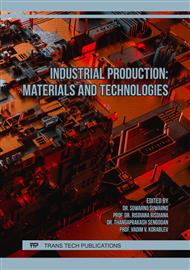[1]
J. H. Kima, D. S. Joa, B. M. Kimb, Hardness prediction of weldment in friction stir welding of AA6061 based on numerical approach, Procedia Engg. 207 (2017) 586-590.
DOI: 10.1016/j.proeng.2017.10.1025
Google Scholar
[2]
J. Y. Sheikh-Ahmad, D. S. Ali, S. Deveci, F. Almaskari, F. Jarrar, Friction stir welding of high density polyethylene-Carbon black composite, J. Mater Proc. Tech. 264 (2019) 402-413.
DOI: 10.1016/j.jmatprotec.2018.09.033
Google Scholar
[3]
R. Kumar, R. Singh, IPS Ahuja, Friction stir welding of ABS-15Al sheets by introducing compatible semi-consumable shoulder-less pin of PA6-50Al, Measurement 131 (2019) 461-472.
DOI: 10.1016/j.measurement.2018.09.005
Google Scholar
[4]
S. S. Kumar, N. Murugan, K. K. Ramachandran, Identifying the optimal FSW process parameters for maximizing the tensile strength of friction stir welded AISI 316L butt joints, Measurement 137 (2019) 257-271.
DOI: 10.1016/j.measurement.2019.01.023
Google Scholar
[5]
A. Kuppusamy, Lakshminarayanan, Enhancing the properties of friction stir welded stainless steel joints via multi-criteria optimization, Archives of Civil Mech. Engg. 16 (2016) 605-617.
DOI: 10.1016/j.acme.2016.03.012
Google Scholar
[6]
S. S. Kumar, N. Murugan, K. K. Ramachandran, Microstructure and mechanical properties of friction stir welded AISI 316L austenitic stainless steel joints, J. Mater Proc. Tech. 254 (2018) 79-90.
DOI: 10.1016/j.jmatprotec.2017.11.015
Google Scholar
[7]
M. Raturi, A. Garg, A. Bhattacharya, Joint strength and failure studies of dissimilar AA6061-AA7075 friction stir welds: Effects of tool pin, process parameters and preheating, Engg. Failure Anal 96 (2019) 570-588.
DOI: 10.1016/j.engfailanal.2018.12.003
Google Scholar
[8]
R. K. Kesharwani, S. K. Panda, S. K. Pal, Multi Objective Optimization of Friction Stir Welding Parameters for Joining of Two Dissimilar Thin Aluminum Sheets, Procedia Materials Science 6 (2014) 178-87.
DOI: 10.1016/j.mspro.2014.07.022
Google Scholar
[9]
L Alberto, C D Filippis, L M Serio, D Palumbo, R De Finis, Optimization and Characterization of the Friction Stir Welded Sheets of AA 5754-H111: Monitoring of the Quality of Joints with Thermographic Techniques, Materials 10 (2017) 1010-1165.
DOI: 10.3390/ma10101165
Google Scholar
[10]
G. Rambabu, D. BalajiNaik, C. H. VenkataRaob, K. Srinivasa Rao, G. Madhusudan Reddy Optimization of friction stir welding parameters for improved corrosion resistance of AA2219 aluminum alloy joints, Defence Technol. 11: (2015) 330-337.
DOI: 10.1016/j.dt.2015.05.003
Google Scholar
[11]
V. Ebrahimzadeh, M. Paidar, M. A. Safarkhanian, O. O. Ojo, Orbital friction stir lap welding of AA5456-H321/AA5456-O aluminum alloys under varied parameters, The International Journal of Advanced Manufacturing Technology 96 (2018), 1237-1254.
DOI: 10.1007/s00170-018-1679-5
Google Scholar
[12]
P. Hema, K. Saikumarnaik, K. Ravindranath, Prediction of Effect of Process Parameters on Friction Stir Welded Joints of dissimilar Aluminium Alloy AA2014 & AA6061 Using Taper Pin Profile, Materials Today: Proceedings 4 (2017) 2174-2183.
DOI: 10.1016/j.matpr.2017.02.064
Google Scholar
[13]
C. Zhang, G. Huang, Y. Cao, Y. Zhu, Q. Liu, On the microstructure and mechanical properties of similar and dissimilar AA7075 and AA2024 friction stir welding joints: Effect of rotational speed, Journal of Manufacturing Processes 37 (2019) 470-487.
DOI: 10.1016/j.jmapro.2018.12.014
Google Scholar
[14]
R. Rouzbehania, A. H. Kokabi, H. Sabet, M. Paidar, O.O. Ojo, Metallurgical and mechanical properties of underwater friction stir welds of Al7075 aluminum alloy, Journal of Materials Processing Tech. 262 (2018) 239–256.
DOI: 10.1016/j.jmatprotec.2018.06.033
Google Scholar
[15]
M. Ali, S. Anjum, A. N. Siddiquee, Zahid A. Khan, X. Chen, S. Konovalov, A. Anjum, S. Shakee and H. Ibrahimi, Defect formation during dissimilar aluminium friction stir welded T-joints, Mechanics & Industry 21 (2) (2020) 1-8.
DOI: 10.1051/meca/2020005
Google Scholar
[16]
E. Hoyos, M. C. Serna, Basic Tool Design Guidelines for Friction Stir Welding of Aluminum Alloys. Metals 11 (2021), 2042.
DOI: 10.3390/met11122042
Google Scholar
[17]
R. Khajeh, H. R. Jafarian, R. Jabraeili, A. R. Eivani, S. H. Seyedein, N. Park, A. Heidarzadeh, Strength-ductility synergic enhancement in friction stir welded AA2024 alloy and copper joints: Unravelling the role of Zn interlayer's thickness. J. Mater. Res. Technol. 16, (2022) 251–262.
DOI: 10.1016/j.jmrt.2021.11.133
Google Scholar



